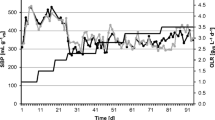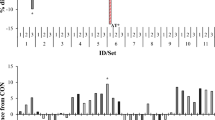Abstract
The macroalga Asparagopsis taxiformis is an effective antimethanogen in ruminants due to the presence of bromoform. To date, research on the effects of A. taxiformis on methanogenesis has used freeze-dried material without an understanding of alternative post-harvest processing methods. Therefore, A. taxiformis was processed using a factorial design based on rinsing (unrinsed/dip rinsed/submerged), freezing (frozen/not frozen) and drying (freeze-dried/kiln-dried/dehydrated) to determine the effects on methane (CH4) production in in vitro rumen fermentations and the concentration of bromoform in the biomass of A. taxiformis. The most effective treatment group, which completely inhibited the production of CH4, consisted of treatments that, regardless of rinsing, were frozen and then freeze-dried. Of these, the unrinsed treatment had the highest concentration of bromoform (4.39 ± 0.07 mg g−1 dry weight (DW)) and the rinsed treatments had concentrations between 2.0 and 3.2 mg g−1 DW. The next most effective group consisted of treatments that were unrinsed, and kiln-dried or dehydrated without freezing. These also completely inhibited the production of CH4 but had lower concentrations of bromoform (between 1.0 and 2.0 mg g−1 DW). Importantly, all other treatments inhibited CH4 by <100% and had bromoform concentrations <1.0 mg g−1 DW, demonstrating that the threshold for complete inhibition of CH4 production in vitro is 1 mg g−1 DW of bromoform in A. taxiformis when included at 2% of organic matter. In conclusion, biomass that was unrinsed, frozen and subsequently freeze-dried was the most effective processing method to maintain antimethanogenic activity, while kiln-drying or dehydrating unrinsed biomass without freezing is also effective.



Similar content being viewed by others
References
Anderson M, Gorley R, Clarke K (2008) PERMANOVA+ for Primer: guide to software and statistical methods. Plymouth: PRIMER-E pp. 214
Beauchemin KA, Kreuzer M, O’Mara F, McAllister TA (2008) Nutritional management for enteric methane abatement: a review. Aust J Exp Agric 48:21–27
Benjamin KJ, Walker DI, McComb AJ, Kuo J (1999) Structural response of marine and estuarine plants of Halophila ovalis (R. Br.) Hook. f. to long-term hyposalinity. Aquat Bot 64:1–17
Bergman EN (1990) Energy contributions of volatile fatty acids from the gastrointestinal tract in various species. Physiol Rev 70:567–590
Bueno ICS, Cabral Filho SLS, Gobbo SP, Louvandini H, Vitti DMSS, Abdalla AL (2005) Influence of inoculum source in a gas production method. Anim Feed Sci Technol 123–124:95–105
Cancho B, Ventura F, Galceran MT (1999) Behavior of halogenated disinfection by-products in the water treatment plant of Barcelona, Spain. Bull Environ Contam Toxicol 63:610–617
Chan JC-C, Cheung PC-K, Ang PO (1997) Comparative studies on the effect of three drying methods on the nutritional composition of seaweed Sargassum hemiphyllum (Turn.) C. Ag. J Agric Food Chem 45:3056–3059
Clarke KR, Gorley R (2006) PRIMER v6: user manual/tutorial. Plymouth: PRIMER-E; p. 190.
Cone JW, van Gelder AH, Driehuis F (1997) Description of gas production profiles with a three-phasic model. Anim Feed Sci Technol 66:31–45
del Val AG, Platas G, Basilio A, Cabello A, Gorrochategui J, Suay I, Vicente F, Portillo E, del Río MJ, Reina GG, Peláez F (2001) Screening of antimicrobial activities in red, green and brown macroalgae from Gran Canaria (Canary Islands, Spain). Int Microbiol 4:35–40
Dubois B, Tomkins NW, Kinley RD, Bai M, Seymour S, Paul NA, de Nys R (2013) Effect of tropical algae as additives on rumen in vitro gas production and fermentation characteristics. Am J Plant Sci 4:34–43
Durmic Z, Moate PJ, Eckard R, Revell DK, Williams R, Vercoe PE (2014) In vitro screening of selected feed additives, plant essential oils and plant extracts for rumen methane mitigation. J Sci Food Agric 94:1191–1196
Genovese G, Faggio C, Gugliandolo C, Torre A, Spanò A, Morabito M, Maugeri TL (2012) In vitro evaluation of antibacterial activity of Asparagopsis taxiformis from the Straits of Messina against pathogens relevant in aquaculture. Mar Environ Res 73:1–6
Goering H, Van Soest P (1970) Forage fiber analyses (apparatus, reagents, procedures, and some applications): agriculture handbook no. 379. U.S Agricultural Research Service, Washington
Gupta S, Cox S, Abu-Ghannam N (2011) Effect of different drying temperatures on the moisture and phytochemical constituents of edible Irish brown seaweed. LWT - Food Sci Technol 44:1266–1272
Hutson KS, Mata L, Paul NA, de Nys R (2012) Seaweed extracts as a natural control against the monogenean ectoparasite, Neobenedenia sp., infecting farmed barramundi (Lates calcarifer). Int J Parasitol 42:1135–1141
IPCC (2014) Climate change 2014: synthesis report. Contribution of working groups I, II and III to the fifth assessment report of the intergovernmental panel on climate change. Core Writing Team, RK Pachauri and LA Meyer (eds.). Geneva, Switzerland: IPCC. pp. 151
Kamra DN (2005) Rumen microbial ecosystem. Curr Sci 89:124–135
Karlsson JOM, Toner M (1996) Long-term storage of tissues by cryopreservation: critical issues. Biomaterials 17:243–256
Kinley RD, de Nys R, Vucko MJ, Machado L, Tomkins NW (2016a) The red macroalgae Asparagopsis taxiformis is a potent natural antimethanogenic that reduces methane production during in vitro fermentation with rumen fluid. Anim Prod Sci 56:282–289
Kinley RD, Vucko MJ, Machado L, Tomkins NW (2016b) In vitro evaluation of the antimethanogenic potency and effects on fermentation of individual and combinations of marine macroalgae. Am J Plant Sci 7:2038–2054
Knapp JR, Laur GL, Vadas PA, Weiss WP, Tricarico JM (2014) Enteric methane in dairy cattle production: quantifying the opportunities and impact of reducing emissions. J Dairy Sci 97:3231–3261
Le Lann K, Jégou C, Stiger-Pouvreau V (2008) Effect of different conditioning treatments on total phenolic content and antioxidant activities in two Sargassacean species: comparison of the frondose Sargassum muticum (Yendo) Fensholt and the cylindrical Bifurcaria bifurcata R. Ross. Phycol Res 56:238–245
Ling ALM, Yasir S, Matanjun P, Abu Bakar MF (2015) Effect of different drying techniques on the phytochemical content and antioxidant activity of Kappaphycus alvarezii. J Appl Phycol 27:1717–1723
López S, Dhanoa MS, Dijkstra J, Bannink A, Kebreab E, France J (2007) Some methodological and analytical considerations regarding application of the gas production technique. Anim Feed Sci Technol 135:139–156
Machado L, Magnusson M, Paul NA, de Nys R, Tomkins NW (2014) Effects of marine and freshwater macroalgae on in vitro total gas and methane production. PLoS One 9:e85289
Machado L, Magnusson M, Paul NA, Kinley R, de Nys R, Tomkins NW (2016a) Identification of bioactives from the red seaweed Asparagopsis taxiformis that promote antimethanogenic activity in vitro. J Appl Phycol 28:3117–3126
Machado L, Magnusson M, Paul NA, Kinley R, de Nys R, Tomkins NW (2016b) Dose-response effects of Asparagopsis taxiformis and Oedogonium sp. on in vitro fermentation and methane production. J Appl Phycol 28:1443–1452
Magnusson M, Mata L, de Nys R, Paul NA (2014) Biomass, lipid and fatty acid production in large-scale cultures of the marine macroalga Derbesia tenuissima (Chlorophyta). Mar Biotechnol 16:456–464
Magnusson M, Carl C, Mata L, de Nys R, Paul NA (2016) Seaweed salt from Ulva: a novel first step in a cascading biorefinery model. Algal Res 16:308–316
Mata L, Wright E, Owens L, Paul N, de Nys R (2013) Water-soluble natural products from seaweed have limited potential in controlling bacterial pathogens in fish aquaculture. J Appl Phycol 25:1963–1973
Menke KH, Steingass H (1988) Estimation of the energetic feed value obtained from chemical analysis and in vitro gas production using rumen fluid. Anim Res Dev 28:7–55
Moate PJ, Williams SRO, Grainger C, Hannah MC, Ponnampalam EN, Eckard RJ (2011) Influence of cold-pressed canola, brewers grains and hominy meal as dietary supplements suitable for reducing enteric methane emissions from lactating dairy cows. Anim Feed Sci Technol 166–167:254–264
Moate PJ, Deighton MH, Williams SRO, Pryce JE, Hayes BJ, Jacobs JL, Eckard RJ, Hannah MC, Wales WJ (2016) Reducing the carbon footprint of Australian milk production by mitigation of enteric methane emissions. Anim Prod Sci 56:1017–1034
Morgavi DP, Forano E, Martin C, Newbold CJ (2010) Microbial ecosystem and methanogenesis in ruminants. Animal 4:1024–1036
Muldrew K, McGann LE (1994) The osmotic rupture hypothesis of intracellular freezing injury. Biophys J 66:532–541
National Health and Medical Research Council (2013) Australian code for the care and use of animals for scientific purposes, 8th edn. National Health and Medical Research Council, Canberra, p. 92
Paul NA, de Nys R, Steinberg PD (2006a) Chemical defence against bacteria in the red alga Asparagopsis armata: linking structure with function. Mar Ecol Prog Ser 306:87–101
Paul NA, de Nys R, Steinberg PD (2006b) Seaweed-herbivore interactions at a small scale: direct tests of feeding deterrence by filamentous algae. Mar Ecol Prog Ser 323:1–9
Persson PO, Londahl G (1993) Freezing technology. In: Mallett CP (ed) Frozen food technology. Blackie Academic and Professional, Glasgow, pp. 20–58
R: a language and environment for statistical computing (2013) Vienna, Austria: R Foundation for Statistical Computing. http://www.r-project.org
Ratti C (2001) Hot air and freeze-drying of high-value foods: a review. J Food Eng 49:311–319
Robic A, Sassi JF, Lahaye M (2008) Impact of stabilization treatments of the green seaweed Ulva rotundata (Chlorophyta) on the extraction yield, the physico-chemical and rheological properties of ulvan. Carbohydr Polym 74:344–352
Rymer C, Huntington JA, Williams BA, Givens DI (2005) In vitro cumulative gas production techniques: history, methodological considerations and challenges. Anim Feed Sci Technol 123–124:9–30
Sablani SS (2006) Drying of fruits and vegetables: retention of nutritional/functional quality. Dry Technol 24:123–135
Tavendale MH, Meagher LP, Pacheco D, Walker N, Attwood GT, Sivakumaran S (2005) Methane production from in vitro rumen incubations with Lotus pedunculatus and Medicago sativa, and effects of extractable condensed tannin fractions on methanogenesis. Anim Feed Sci Technol 123–124:403–419
Vergés A, Paul NA, Steinberg PD (2008) Sex and life-history stage alter herbivore responses to a chemically defended red alga. Ecology 89:1334–1343
Wang Y, Xu Z, Bach SJ, McAllister TA (2008) Effects of phlorotannins from Ascophyllum nodosum (brown seaweed) on in vitro ruminal digestion of mixed forage or barley grain. Anim Feed Sci Technol 145:375–395
Wong K, Cheung PC (2001) Influence of drying treatment on three Sargassum species 1. Proximate composition, amino acid profile and some physico-chemical properties. J Appl Phycol 13:43–50
Acknowledgments
Thanks to A. Angell, A. Wegner, T. Mannering, D. Roberts and Z. Loffler for help in collecting A. taxiformis and post-harvest processing of samples. A special thanks to T. Mannering for the pump.
Author information
Authors and Affiliations
Corresponding author
Rights and permissions
About this article
Cite this article
Vucko, M.J., Magnusson, M., Kinley, R.D. et al. The effects of processing on the in vitro antimethanogenic capacity and concentration of secondary metabolites of Asparagopsis taxiformis . J Appl Phycol 29, 1577–1586 (2017). https://doi.org/10.1007/s10811-016-1004-3
Received:
Revised:
Accepted:
Published:
Issue Date:
DOI: https://doi.org/10.1007/s10811-016-1004-3




